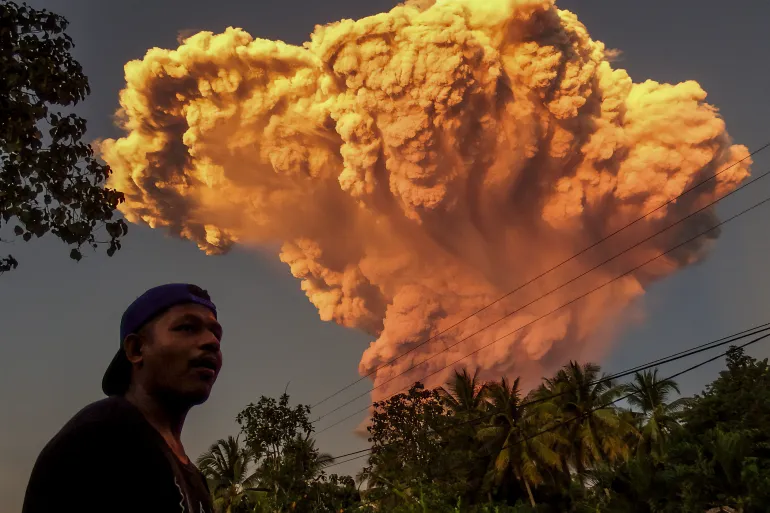Flights to Australia, Singapore disrupted after volcano eruption rocks Bali resort island

Indonesia’s Mount Lewotobi Laki-Laki Erupts Again, Spews Ash 10 km High
In News:
On October 15, 2025, Mount Lewotobi Laki-Laki, located on Flores Island in East Nusa Tenggara, Indonesia, erupted violently, sending a towering column of volcanic ash up to 10 km (6.2 miles) into the atmosphere. Authorities have raised the volcano emergency alert to its highest level (Level IV) and ordered residents and tourists to maintain a 6–7 km exclusion zone around the volcano.
Key Facts:
- Time & Duration of Eruption:
The volcano erupted at 1:35 a.m. local time (Tuesday 18:35 GMT) for approximately nine minutes, following a smaller eruption just two hours earlier. - Height of Ash Plume:
Volcanic materials were ejected 10 km above the 1,584-meter (5,080-foot) peak.
The ash plume was described as thick and dark, posing a potential hazard to aviation operations. - Alert Level:
Raised to Level IV — the highest on Indonesia’s volcanic alert system, indicating continuous and powerful eruptions with a risk to surrounding settlements. - Safety & Exclusion Zone:
- Residents and tourists have been warned to stay at least 6–7 km away from the crater.
- Authorities also cautioned about volcanic mudflows (lahars) if heavy rains occur.
- Airport & Transport Impact:
- The Fransiskus Xaverius Seda Airport in Maumere, around 60 km west of Lewotobi, has been temporarily closed until Thursday due to ash hazards.
- Flight paths could be disrupted if the ash cloud drifts further, the Geological Agency warned.
- Past Activity:
- July 2025: Eruption sent ash 18 km high, disrupting flights from Bali International Airport.
- March 2025: A smaller eruption led to the cancellation of several international flights to Australia, Singapore, and Malaysia.
- November 2024: A deadly eruption killed 10 people, damaged thousands of homes, and forced mass evacuations.
- Geological Context:
Mount Lewotobi consists of twin volcanoes—- Lewotobi Laki-Laki (“Man”) — the more active cone
- Lewotobi Perempuan (“Woman”) — relatively dormant
Both belong to the Sunda–Banda volcanic arc within the Pacific Ring of Fire, one of the world’s most seismically active regions.
Static Part – Key Concepts:
1. Pacific Ring of Fire:
A 40,000 km horseshoe-shaped zone around the Pacific Ocean with frequent earthquakes and volcanic eruptions due to intense tectonic plate subduction. Indonesia lies at its core, hosting over 120 active volcanoes, the most of any nation.2. Lahar (Volcanic Mudflow):
A dangerous slurry of volcanic ash, debris, and water that flows rapidly down slopes, often triggered by heavy rainfall during or after eruptions.3. Volcanic Alert Levels (Indonesia):
- Level I: Normal
- Level II: Advisory (Increasing activity)
- Level III: Watch (Possible eruption)
- Level IV: Warning (Ongoing major eruption)
Significance:
- Highlights Indonesia’s ongoing volcanic risk management challenges, given its location on converging tectonic plates.
- Demonstrates the regional impact on aviation safety and tourism due to volcanic ash clouds.
- Offers opportunities for enhanced volcanic monitoring systems, satellite surveillance, and disaster preparedness programs in the Pacific region.
Updated - 15 Oct 2025 ; 9 : 23 PM | ALJAZEERA